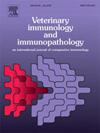使用商业抗体对福尔马林和锌固定、石蜡包埋的鸡鸭组织免疫细胞亚群进行免疫组织化学鉴定
IF 1.4
3区 农林科学
Q4 IMMUNOLOGY
引用次数: 0
摘要
家禽免疫细胞的免疫组织化学鉴定主要是使用冷冻组织进行的,在石蜡包埋组织中鉴定有限。在本研究中,我们检测了以下18种市买的与免疫细胞表型相关的一抗:抗cd3、CD4(克隆CT-4和2‐35)、TCRγδ、TCRαVβ1、TCRαVβ2、CD8、BAFF-R、PAX5、bus -1a/b、Iba-1、MRC1L-B、CSF-1R、TIM4、MHC II类(克隆2D5和21‐1A6)、MUM1和CD45抗体在福尔马林固定石蜡包埋(FFPE)和锌固定石蜡包埋(ZFPE)鸡鸭淋巴组织中的抗体。在鸡中,在某些抗原回收条件下,FFPE组织中的11种抗体和ZFPE组织中的16种抗体与预期抗原发生反应。针对CD4(克隆CT-4)、TCRγδ、TCRαVβ1、CSF-1R和MHC II类(克隆21‐1A6)的抗体仅在ZFPE组织中有效。在鸭子中,FFPE和ZFPE组织中的细胞在某些测试条件下被五种抗体免疫标记。适用于细胞膜抗原的抗原回收对于FFPE组织趋向于加热,对于ZFPE组织趋向于不处理。热诱导抗原检索允许更好地检测核抗原在FFPE和ZFPE切片。我们的结果表明,市售抗体可以免疫组织化学检测石蜡包埋切片中鸡和鸭的一些免疫细胞亚群。本文章由计算机程序翻译,如有差异,请以英文原文为准。
Immunohistochemical identification of immune cell subsets in formalin- and zinc-fixed, paraffin-embedded tissues from chicken and duck using commercial antibodies
Immunohistochemical identification of immune cells in poultry has primarily been performed using frozen tissues, with limited identification in paraffin-embedded tissues. In this study, the following 18 commercially available primary antibodies associated with immune cell phenotypes were tested: anti-CD3, CD4 (clone CT-4 and 2‐35), TCRγδ, TCRαVβ1, TCRαVβ2, CD8, BAFF-R, PAX5, Bu-1a/b, Iba-1, MRC1L-B, CSF-1R, TIM4, MHC class II (clone 2D5 and 21‐1A6), MUM1, and CD45 antibodies in formalin-fixed, paraffin-embedded (FFPE) and zinc-fixed, paraffin-embedded (ZFPE) chicken and duck lymphoid tissues. In chickens, 11 antibodies in FFPE tissue and 16 in ZFPE tissue reacted with the expected antigens under some of the antigen retrieval conditions tested. Antibodies against CD4 (clone CT-4), TCRγδ, TCRαVβ1, CSF-1R, and MHC class II (clone 21‐1A6) were effective only in ZFPE tissue. In ducks, cells in both FFPE and ZFPE tissues were immunolabeled by five antibodies under some of the conditions tested. Antigen retrieval suitable for cellular membrane antigen tended to be heat for FFPE tissues and no treatment for ZFPE tissues. Heat-induced antigen retrieval allowed for better detection of nuclear antigens in both FFPE and ZFPE sections. Our results indicate that commercially available antibodies can immunohistochemically detect some of chicken and duck immune cell subsets in paraffin-embedded sections.
求助全文
通过发布文献求助,成功后即可免费获取论文全文。
去求助
来源期刊
CiteScore
3.40
自引率
5.60%
发文量
79
审稿时长
70 days
期刊介绍:
The journal reports basic, comparative and clinical immunology as they pertain to the animal species designated here: livestock, poultry, and fish species that are major food animals and companion animals such as cats, dogs, horses and camels, and wildlife species that act as reservoirs for food, companion or human infectious diseases, or as models for human disease.
Rodent models of infectious diseases that are of importance in the animal species indicated above,when the disease requires a level of containment that is not readily available for larger animal experimentation (ABSL3), will be considered. Papers on rabbits, lizards, guinea pigs, badgers, armadillos, elephants, antelope, and buffalo will be reviewed if the research advances our fundamental understanding of immunology, or if they act as a reservoir of infectious disease for the primary animal species designated above, or for humans. Manuscripts employing other species will be reviewed if justified as fitting into the categories above.
The following topics are appropriate: biology of cells and mechanisms of the immune system, immunochemistry, immunodeficiencies, immunodiagnosis, immunogenetics, immunopathology, immunology of infectious disease and tumors, immunoprophylaxis including vaccine development and delivery, immunological aspects of pregnancy including passive immunity, autoimmuity, neuroimmunology, and transplanatation immunology. Manuscripts that describe new genes and development of tools such as monoclonal antibodies are also of interest when part of a larger biological study. Studies employing extracts or constituents (plant extracts, feed additives or microbiome) must be sufficiently defined to be reproduced in other laboratories and also provide evidence for possible mechanisms and not simply show an effect on the immune system.

 求助内容:
求助内容: 应助结果提醒方式:
应助结果提醒方式:


